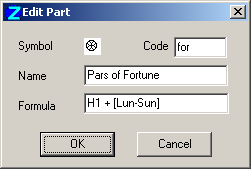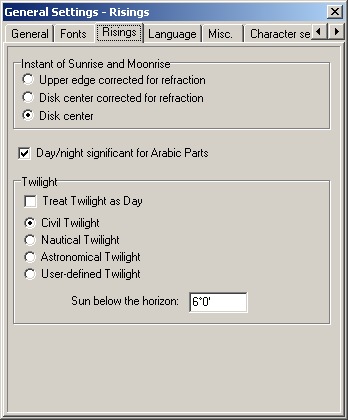Arabic Parts
The Arabic Parts window lets you select and work with
Arabic Parts (Pars). It is opened by clicking the  "Tables"
Toolbar button or selecting the "Tables" main menu item, then selecting
the
"Tables"
Toolbar button or selecting the "Tables" main menu item, then selecting
the  Arabic Parts menu option.
Arabic Parts menu option.
Since Parts must be recomputed whenever the event data changes, it is necessary to limit the number of Parts active in a chart. At present the total number of asteroids, fictitious objects, and Parts is not allowed to exceed 86 in total. To offset this restriction, ZET allows you to create sets ('pages') of Parts. Thus, with the minor inconvenience of switching pages and recasting the chart, you can make use of as many different Parts as you require.

The Arabic Parts window consists of two resizeable panes. The left pane (visible if the "Page List" menu option is checked) contains a list of available pages (i.e. sets of parts), with the current page highlighted. Clicking the mouse in this list selects a page for operations. The right pane lists the Parts, each line consisting of the following information: activation status, glyph, name, the formula used to calculate it, and the code used to refer to it when marking-up interpretation texts.
The column widths of the table can be adjusted by clicking and dragging the column separators in the header line.
To activate or deactivate a Part for use, double-click a line of the table. Active Parts are checkmarked (ticked).
Right-clicking in the table displays a popup menu of options:
- Activate Pars - activates or deactivates the Part. The display properties of the Part should be adjusted on the Chart Settings - Planets tab,
- Edit... - see below,
- Delete - deletes the highlighted Pars,
- New... - creates a blank row under the highlighted Pars, which you can select and edit to create a new Part,
- True Asc -or- Cusp of I House - selects between use of the Ascendant or the First House Cusp when calculating Parts. This option caters for house systems in which cusps do not coincide with start of houses but signify positions of greatest influence, e.g. by falling in the center of houses,
- Use for Degree Overview - if checked, all Parts on the current page will be candidates for the Degree Overview window, regardless of their activation status. See Chart Settings - Data tab,
- Create PARS.TXT - writes the current values, names and formulas of the Parts of the current table to the file Pars.txt in the [ZET]\Wrk folder, and also opens the file in a text editor window,
- Page List - displays (or hides) the pane listing pages of Parts.
The popup menu of the page list contains:
- New Page - creates a new (empty) page. You are required to name the new Parts page,
- Rename Page - allows you to rename an existing set of Parts,
- Delete Page - deletes the current set of Parts after confirming with the user.
Editing Parts
The Edit Part dialog is opened by selecting the "Edit" option from the popup menu of the Arabic Parts main pane.

To edit or create a glyph for the Part for use in charts, click the Symbol icon to open the Glyph Editor. After selecting or drawing the symbol, click "OK" to accept the result and exit the Glyph Editor.
To name the Pars, click in the Name field and type a name of your choice.
To edit or create a Pars Formula, use the following abbreviated designations for chart elements:
Planets Uranian Planets Sun Sun Cup Cupido Lun Moon Had Hades Mer Mercury Zeu Zeus Ven Venus Kro Kronos Mar Mars Apo Apollon Jup Jupiter Adm Admetos Sat Saturn Vul Vulkanus Ura Uranus Pos Poseidon Nep Neptune Plu Pluto House cusps Nod North Node H1 ... H12 SNd South Node Lil Lilith House rulers Chi Chiron D1 ... D12 S - prenatal syzygy
Two letters abbreviation allowed: SO, MO, ME, VE, MA, JU, SA, UR, NE, PL, KN, SN, LI, CH.
Part's formulae "Dispositor of Planet" (ruler of sign, in which the planet is located), e.g., "D.SO" means "dispositor of Sun", or syzygy, i.e. "D.S" specifies a planet - ruler of sign, in which a prenatal syzygy is licated.
Part's formulae "Third of House" (e.g., "T2.H5" - the begin of second third of fifth house, "T3.H10" - the begin of last third of tenth house).
You can include numeric constants in formulas to represent absolute values. The number should be an integer or decimal fraction, e.g. 242.652,
It is possible to use any virtual object (using its name, e.g. Galactic_Center) or asteroid (designated by catalog number, e.g. A10199).
Specific points in a planet's orbit can be specified using this syntax:
At.Planet, where
- A = orbital element: 'A' - aphelion, 'P' - perihelion, 'N' - north node, 'S' - south node, 'F' - 2nd focus of orbit;
- t = type of element: 't' - true, 'b' - barycentric;
- Planet = planet name.
A.Sun - aphelion of Sun (mean),
Nt.Jup - true north node of Jupiter (geocentric).
There is a possibility to use stars in formulas of lots (Arabic Parts), for example, "Widowhood lot": H1 + @Vindemiatriks-NE. The space in a name of a star is replaced with a symbol "_", for example @Ras_Algethi. It is possible to set a star it number in the catalog Bright Star, for example, @4819 (gamma Centauri). At calculation of a lot the precession and own movement of a star is considered.
The following operators are available:
- Addition "+", for example Sun + Lun
- Subtraction "-", for example Sun - Nod (Draconic Sun)
- Multiplication "*", for example Sun*2
- Midpoint "/", for example Sun / Lun (Solilunar midpoint)
The formula is calculated left to right, all operations having the same priority. E.g. Sun+180*0.1 means that 180 degrees is added to the Sun's longitude (by modulo 360) and the result is multiplied by 0.1.
Square brackets [...] in a formula indicate that daytime and night-time are to be distinguished when calculating the value. During daytime, the formula is calculated as-is, i.e. ignoring the square brackets. During night-time, the sign preceding the left bracket is inverted. Example: Pars Fortune is defined by the formula H1+[Lun-Sun]. For daytime births this is equivalent to 'H1+Lun-Sun'. At night-time it evaluates to 'H1-Lun+Sun'. Night-time is defined as the interval between the end of dusk twilight and the start of dawn twilight. The duration of twilight is adjusted on the Risings tab of the General Settings window.

Code for Interpreter
Arabic Parts can be used in Horoscope Reading interpretations. The interpretation texts dealing with Parts should be marked-up using a predefined code to refer to each Parts. The codes must be defined in the page of Arabic Parts to be used in the interpretation. Codes are required be 3 characters long, and lower-case, for example, for, kre. The assignment of specific codes to Parts is at the user's choice.
The resulting interpretation texts after marking-up for Parts will look similar to this:
- [for.AR] Pars Fortuna in Aries ...
- [for.01] Pars Fortuna in First House ...
- [for.CNJ.SU] Pars Fortuna Conjunct Sun ...
- and so on.
To define a Part's Code, select the "Edit" menu option to display the Edit Part window (see above), and input the code in the Code field.
Ensure that Parts you have defined and/or activated for calculation are shown on the natal chart by selecting them in Chart Settings, Planets tab.